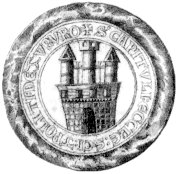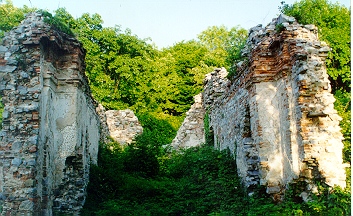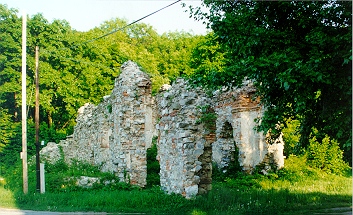
| Monasteries and orders |

|

Coat of arms of Zobor monastery dated from 14th century
St. Hyppolytus - (c. 170-235 C.E.), the monastery in Zobor was named in the honour of him. He was a presbyter in Rome. He critisized the Roman Bishops Zephyrinus (198-217) and Callistus (217-222), and stressed the need for a more firm position against Modalism. Hyppolytus was also against policy of concerning forgiveness of sins in then Roman Empire. Finally he was exiled to the Sardinian mines, where he died. He also wrote several works which are preserved in translations. The body of him was later brought back to Rome. Since then he has been considered martyr.
"Zobor document" of 1111
Cross of Knights of Malta
Coat of arms Templar knights
Crusades - on the request of Byzantine Emperor Alexios I Komnenos, Pope Orban II (1088 - 1099), in Clermont, France called for the fight against Turkish troops who occupied Holy land Jerusalem and Palestina. There were 8 Crusades between 1097 - 1270. After some short-period successes, the aim of the crusades, to free Holy land, was not achieved.
|
Benedictine monastery of St. Hyppolite in Zobor
At the foot of Zobor hill still lies in ruins former monastery. Its foundation is not known yet. It is believed that the origin dates back in the 9th century in the great moravian period, but at the end of the 10th century stood at the latest. Whenever built, it is the oldest monastery in Slovakia.
In Zobor monastery lived monks ruled by an abbot. The benedictines are an agricultural order which teach people living near their possesions to proggresive farming. They planted vineyards on Zobor and lay the foundations to winegrowing and viniculture which became famous later in Nitra. Abbey property stretched discontinuitly over west present-day Slovakia. The monastery was involved in "Zoborské listiny", Zobor documents, the oldest and the most precious well-preserved documents of Slovakia. They were written in 1111 and 1113 and now are kept in the Castle. The first document solves a dispute between the monastery and royal collectors taxes about ownership of the tolls. The latter document of 1113 contains the inventory of the Zobor abbey and describes more than 150 villages. The monastery provided shelter for the marchents and their goods which were safe here during the night, before going on.
The monks had lived here until 1468 when administrator of the see Ján Vitéz took over the monastery and asked the king Matthias Corvinus to revert to the Pope to confirm this state. The Pope Paul II issued the Bull, on 17 September 1468, and handed over the possesions of the monastery to the See.
In 1471 the building was destroyed by Polish troops of Kazimír.
Bishop Blažej Jaklin built a new monastery on the same place in 1692 - 1695 for the Camaldolese Order. Beside praying and manual labour, the monks dealt with the trade and the science. Philologian, the author of Latin-Slovak dictionary P. Romuald Hadbavný worked here. The monastery served as the only one noviciate for the Camaldolese order in Hungarian Kingdom. In 1782, the Emperor Joseph II abolished numerous monasteries and "Zobor" was among them. The building later served to several purposes. The cloth manufactory had worked here since 1786. However, a couple of years later turned bankrupt. In 1850 the building was bought by Bishop Roškováni. As the building was set in agreeable ambient conditions, Bishop constituted here the facility for people with lungs diseases which was visited by the guests even from Balkan. The tavern here was a famous place for the trips.
In 1930´s the mansard roof was built and on July 1, 1953 the sanatory was opened.
The orders in Nitra
Order - (lat. Ordo) - a community of persons living in seclusion from the world, under religious vows and subject to a fixed rule, as monks, friars, nuns, or in general as religious. A specific offshoot of the orders were the Military Orders.
Benedictines - Ordo Sancti Benedicti - The Benedictine Order is the oldest in western Europe and comprises monks living under the Rule of St. Benedict. St. Benedict of Nursia, is the founder of western monasticism, born at Nursia, in 480, died at Monte Cassino, 543. He founded the celebrated Abbey of Monte Cassino in 529, which eventually become the centre whence his Rule and institute spread. They seated in Nitra between 9th or 10th century to 1470.
Camaldolese - Camaldulensians - A joint order of hermits and cenobites, founded by St. Romuald (951 - 1027) at the beginning of the eleventh century. About 1012, after having founded or reformed nearly a hundred unconnected monasteries and hermitages, St. Romuald arrived in the Diocese of Arezzo in Tuscony, seeking place for a new hermitage. There the famous hermitage afterwards known as Campus Maldoli or Camaldoli was built. The order officially come into existence when the Bull "Nulli fidelium", of Alexander II, in 1072 was issued.
The Camaldolese Order had worked in Nitra in Zobor monastery from 1695 to 1782.
Franciscans - a mendicant order founded by St. Francis of Assisi in 1209. They appeared in Nitra in 1230 or 1238 having their monastery at the edge of then town until 1552, when their monastery was destroyed by the Turks. The Franciscans came back in the town in 1630 and new monastery and church built Bishop Telegdy for them which are still standing.
Piarists - called also Clerks Regular of the Pious Schools, Scolopli, Escolapios, Poor Clerks of the Mother of God, and the Pauline Congregation, a religious order founded in Rome in 1597 by St. Joseph Calasanctius. The Piarists have won distinction in the sphere of education. Their first care is to provide education. They had a province in Hungary and in 1698 they came from Prievidza in Nitra and established a higher Catholic Grammar school. Later a church was built and is still one of the landmarks of the town.
Nazarenes - Spanish order, founded by Ján Varela in 1750. There were called to Nitra in 1766 from Spain by Bishop Gustíni who built a monastery for them at the church on Marian hill to look after the church and people traveling here regularly for pilgramage. One year later the monks left, because the order was not confirmed neither by the pope nor by the monarch and the Nazarenes were abolished by a royal decree.
Vincentians - Sisters of Charity of St. Vincent de Paul (1580 - 1660). A congregation of women with simple vows, founded in 1633 and devoted to corporal and spiritual works of mercy. Their full title is Sisters or Daughters of Charity (the founder preferred the latter term), Servants of the Sick Poor. The term "of St. Vincent de Paul" has been added to distinguish them form several communities of Sisters of Charity, animated with a similar spirit, among whom they rank in priority of origin and greatness of numbers. They were called to Nitra by Bishop Palúcky on September 9, 1861 from Graz. Their mission were upbringing of girls and established the schools of all levels for girls here. A church for them was built in the half of the 19th century in th centre of the town.
Premonstratensian Canons - (Canonici Regulares Prémonstratenses). Founded in 1120 by St. Norbert at Prémontré, near Laon, France. At first they were not bound by any fixed rule, charity being the bond of their union, and the example of their founder their rule of life. They appeared in Nitra in 1939.
The Military Orders
A regular order of knighthood means a brotherhood or confraternity which combines with the insignia of knighthood the privileges of monks. The great military orders had their origin in the crusades, from which they retain the common badge of every order of knighthood -- the cross worn on the breast.
Hospitallers of St. John of Jerusalem - (Also known as Knights of Malta or The Order of St. John)
The most important of all the military orders, both for the extent of its area and for its duration. It is said to have existed before the Crusades and is not extinct at the present time. During this long career it has not always borne the same name. Known as Hospitallers of Jerusalem until 1309, the members were called Knights of Rhodes from 1309 till 1522, and have been called Knights of Malta since 1530. The rescue of the holy places of Palestine from Moslem domination and the defense of pilgrims became the new object of his vow. In return, the Church took him under her protection in a special way, and conferred upon him exceptional temporal and spiritual privileges, such as the remission of all penances, dispensation from the jurisdiction of the secular courts, and as a means of defraying the expenses of the journey to the Holy Land, knights were granted the tenth of all the church revenues.
The vow of the crusader was limited to a specified period. For the distant expeditions into Asia, the average time was two or three years.
Among the most important military orders can be ranked Templar knights and Teutonic knights. The first was abolished in 14th century and the latter is still in existence, even in Slovakia.
|


Present-day appearance of the former Camaldolese monastery. The ruins are situated at the foot of Zobor hill in Nitra. At this site used to stand Benedictine monastery of 9th or 10th century, the oldest in Slovakia.
Intro
Castle
History
Gallery
People
Crafts and guilds
Monastery and orders
Contact